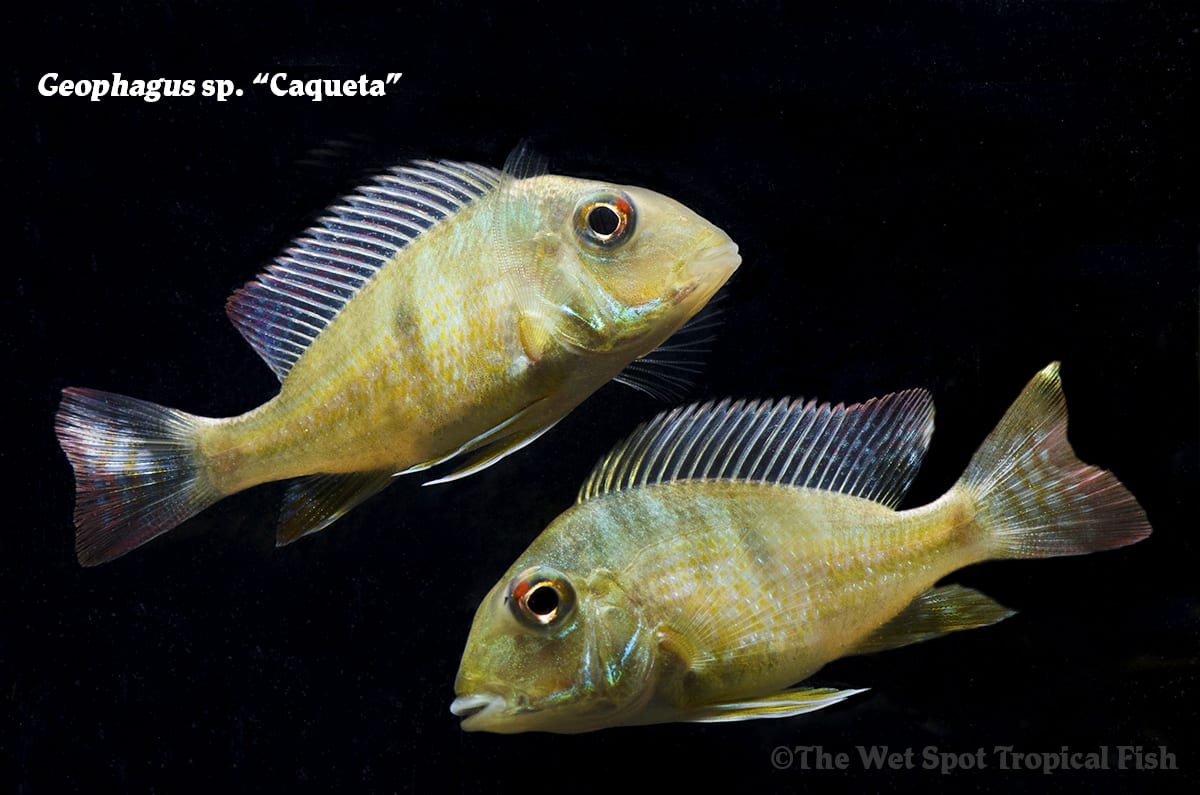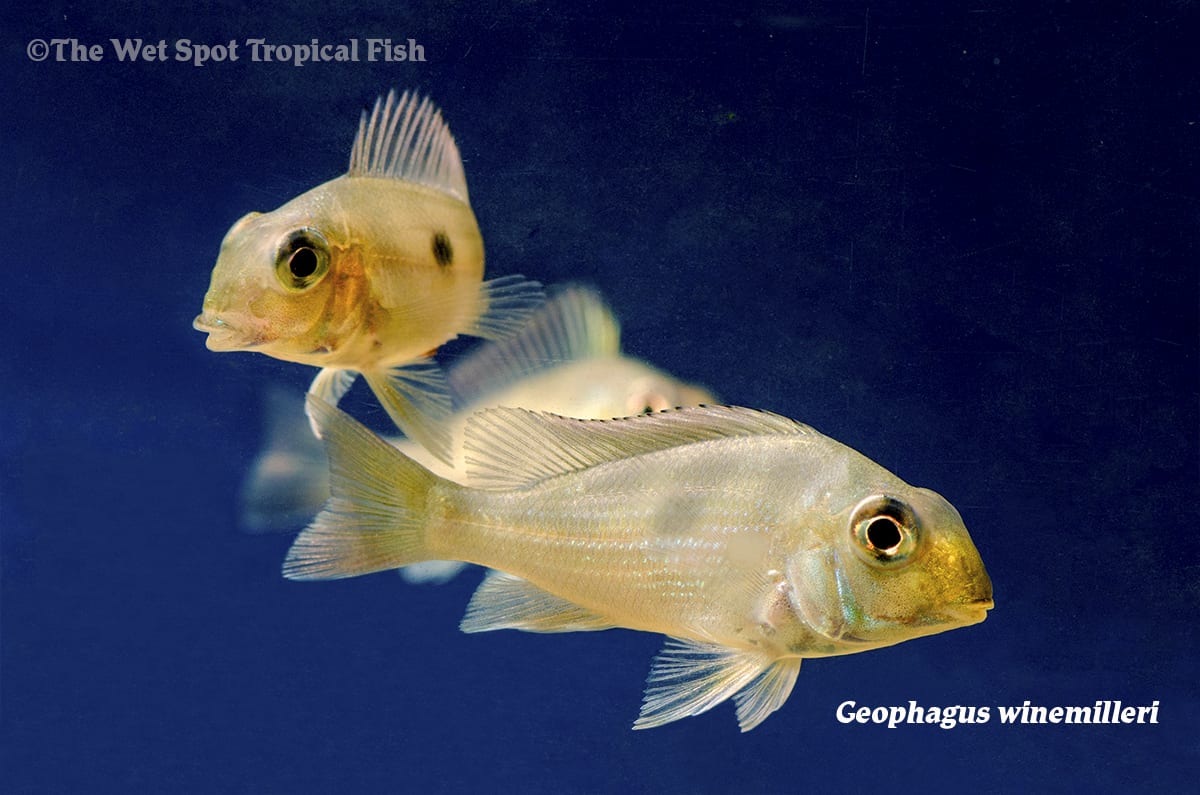Memory Stream
Memory Stream
With the weekend holiday representing a time of rebirth, we’d like to take a moment to appreciate our roots. The Wet Spot began with our founder’s passion for procuring, raising, and breeding rare tropical cichlids, and making these unique specimens available to the rest of the hobbyist market. With thousands of freshwater cichlid species in the world spanning from Southeast Asia, to Africa, to Central and South America, needing representation in the aquarist hobby, we began providing them from a small basement operation, which has grown tenfold in the last 16 years. The Wet Spot raises and offers the largest collection of commercially available cichlids on the west coast, and continues to supply and ship these rare species to fish lovers nationally and internationally. This weeks trip down memory “stream” will cover cichlids preferring the freshwater habitats of Central and South American species including Amatitlania sajica, Geophagus sp. “Caqueta”, and Geophagus winemilleri.
Scientific NameAmatitlania sajica
Common NameT-bar Cichlid
Temperature / pH75 to 82°F / 6.0 to 8.0 pH
Native LocationCosta Rica
Preferred DietOmnivorous
Beginning our tour in Central America, A. sajica enjoys swimming the strong currents of freshwater streams on the Pacific slopes of Costa Rica. Also known as the “T-bar Cichlid”, these fish are stunning with tan bodies, yellow cheeks, dark vertical striping with a single lateral strip bisecting the first 4 stripes, with red-spotted dorsal, anal, and caudal fins. Reaching about 3 inches in length in captivity, these fish do well in robust Central American cichlid-specific tanks, but tend to be territorial and aggressive toward many other freshwater species. This behavioral disposition makes these fish excellent parents. Spawning behavior ranges from cave to substrate spawning if the more enclosed settings are scarce. More aggressive males find a female to pair with, and lead her to laying many eggs in a secure location. The male fertilizes the eggs and proceeds to guard eggs and fry until they reach adult size. Tank set-ups should include gravelly substrate with smaller rocks, bogwood, and other furniture to provide spawning sites. These cichlids are omnivores in nature, preferring algal filaments, aquatic insects, seeds and bottom detritus. In captivity they can be fed varied diets of dried flake and pellets, with regular supplementation of live and frozen fare, along with prepared vegetal foods. Waters should be maintained with temperatures between 75 and 82°F, with a pH of 6.0 to 8.0, and hardness of 90 to 447 ppm.
Scientific NameGeophagus sp. “Caqueta”
Common NameNone
Temperature / pH78 to 84°F / 6.0 to 7.0 pH
Native LocationPuerto Rico
Preferred DietSinking foods
Hopping over the Caribbean, and diving into the Rio Guayas of Puerto Rico, the rare and beautiful G. sp. “Caqueta” is found scouring stream bottoms for tasty treats. This cichlid is largely undescribed, though their beauty and unique personalities speak for themselves. Reaching about 4 inches in length, these geos have vertical dark bars over red-spotted flanks with red ventral and anal fins. Gaining their genus epithet from their unique eating behaviors, these cichlids “eat earth”, sifting through substrates of sand, fine gravel and mud for aquatic and terrestrial invertebrates, plant matter, and organic detritus delicacies. Mouthfuls of non-edible substrate escape through modified gill slits. In captivity, these geos will forage continuously along the benthic layer all day, and should be fed multiple small meals of high quality sinking cichlid pellets, live and frozen fare, and at least a small portion of vegetal matter like spirulina daily for optimal health. They do best in tanks with soft sandy substrate, leaf litter, and larger water-worn rocks. This species is unusually peaceful for their kind, and should not be kept with more robust benthic species that may outcompete them. Thus, they make great community fish, and are not aggressive toward species larger than a cm in size. These fish thrive in optimal water conditions of 78 to 84°F, with a pH of 6.0 to 7.0, and hardness of 18 to 143 ppm.
Scientific NameGeophagus winemilleri
Common NameNone
Temperature / pH79 to 86°F / 4.0 to 7.0 pH
Native LocationVenezuela
Preferred DietSinking foods
Moving south, we come to another distinct geo by the name of G. winemilleri in the Amazonas of southern Venezuela. Very rare in the freshwater aquarium hobby, these unique geos reach about 7 inches in length and exhibit beautiful shimmering turquoise stripes over greenish-tan bodies, a dark spot, and red fins. This species is mostly restricted to blackwater habitats with high acidity, soft substrate of sand or mud, roots, branches, and leaf litter. Tank set-ups should mimic these conditions to promote the best color expression. Flat water worn rocks may be included in tanks to provide spawning sites. During spawning, these geos may become territorial and slightly aggressive, though they maintain peaceful dispositions and can be kept in community tanks so long as there are 5-8 conspecifics within the grouping. These geos can follow the same feeding practices as “Caqueta”, though tank conditions will be slightly different. Water temperatures should be maintained between 79 and 86°F, with a pH of 4.0 to 7.0, and hardness of 0 to 143 ppm.
The Wet Spot is indisputably your one-stop shop for all the cichlid information you could desire. Give us a call, and we’ll help you find the best rare-cichlid companions for your carefully curated tanks.


